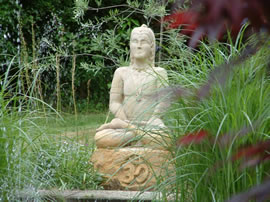Philosophy of Karma Yoga – Swami Indrananda
Sometimes we mistakenly think that any service rendered or action done to a deserving cause, comes under the category of ‘Karma Yoga’, but it is not entirely true. Unless we fully understand the three states i.e. ‘Action’, ‘Inaction’ and ‘forbidden Action’, we may fall short of the required results. The following article, it is hoped, will throw some light on the subject and help us realise our goal.The philsophy of ‘Karma Yoga’ or ‘Action’ and ‘Yoga’ has been described in Bhagvad Gita in Chapters III. IV, XVI, XVII and XVIII. It is interesting to know that the word ‘Karma’ (Action) appears 32 times, slightly less than the word ‘Yoga’ in the whole text whereas Chapter III deals exclusively with ‘Karma Yoga’ and its philosophy is explained in Chapter IV, 16-22.
Sri Swami Sivananda Ji Maharaj says that Karma Yoga is more difficult than Vedanta or Bhakti Yoga. Karma Yoga is not mere mechanical action. The Vedantic Bhava or Bhakti Bhava should be kept up during action or service. (Sadhana, p 202).
Lord Krishna tells Arjuna ‘No one can remain even for a moment without performing action; everyone is made to act helplessly by the impulses born of nature. (.III, 5). Further He says “There is nothing in the three worlds, O Arjuna, that should be done by Me, nor is there anything unattained that should be attained; yet I engage Myself in action. (III,22)
Sri Swami Chidbhavananda Ji says that the Nature is constituted of three Gunas – Sattva, Rajas and Tamas , and is ever in a state of flux Beings involved in Prakriti are therefore helplessly bound by Karma. Vain is their wish and attempt to rid themselves of action; eating, sleeping, breathing, beating of the heart- all these are nothing but Karma. From atom up to the universe all are engaged in activities in innumerable types. It is impossible for beings to renounce karma while being entangled in Prakriti.
None of us can, therefore, escape from ‘actions’ (termed as obligatory duties), but ‘Whatever a great man does, is followed by others; people go by the example he sets up’ (III, 21) encourages us to follow the footsteps of great men. And SwamiJi says that Being eminent with virtues, is a rare gift bestowed upon him/her by God. Persons imbued with godly qualities, are viewed as model to the society.
Sages too, says Lord, are perplexed as to what is action, what inaction (IV, 16) and Verse 17 tells us that ‘it is needful to discriminate action, forbidden action and inaction’.
According to Sri Swami Ramsukhdas Ji the term of ‘Karmayoga’ Karma (actions) are performed for the world, while Yoga (union with God) is for the self. Action and Inaction – these are the two states of action which involve egoism. So long as a man has the egoistic notion, he has affinity for the world; but ‘Yoga’ transcends the two states. In order to realise that ‘Yoga’ it is inevitable to be free from egoism. and to have equanimity during performance or non-performance of actions (II, 48). And if we are unable to realise Him it is because of our affinity for actions and objects born of Nature (Prakriti).
Similarly Swami Chidbhavananda Ji says ‘Action’ is innate in Prakriti and ‘Inaction’ in Atman. The former is kinetic and the latter static; one is the becoming and the other the Being; one is the perishable and other the Imperishable. The ignorant are confused being unable to distinguish between the two.
We should be fully conversant of the various states of actions, and in particular the ‘forbidden Actions’ (see Ch. XVI and XVII). As ‘Work is Worship’ we should never refrain from any karma yoga and perform it to the best of our ability without any egoism, desire for fruit; this will become a stepping stone on our path to achieve the goal of realisation.
Finally, I will conclude it with a great Yogi you and I have known. He was Sri Swami Bhavyananda Ji Maharaj of Ramakrishna Vedanta Centre and a great friend of the Centre. As you may perhaps know that Swami Ji was a medical doctor, and after his initiation to this Order, he was made responsible to run small dispensary to look after the population in his area. As there was no one else with him, he was cleaning the whole dispensary from floor to equipment every day without fail. An Afghan who used to come to India to make money by selling dry fruits, used to pass through the dispensary every now and then. One day he was not feeling well and Swami Ji gave him the treatment. It was to his great astonishment to know that the man who saw cleaning the floor every day, was none else than a doctor himself. He bowed down to Swami Ji and admired his selfless service and offered some of his dry fruits.
Swami Ji was a true Karma and Jnana Yogi, and we should follow footsteps of such Masters.
Om Shanti Sshanti Shanti Om
